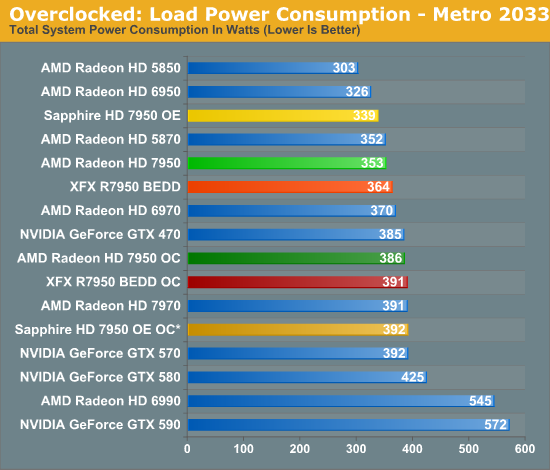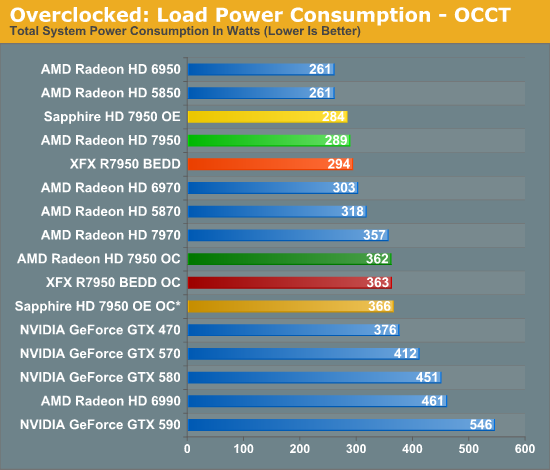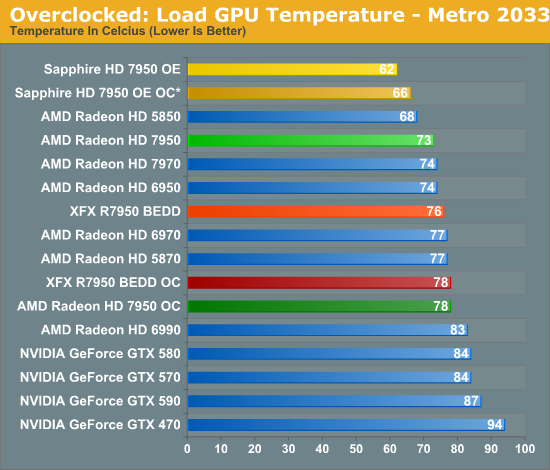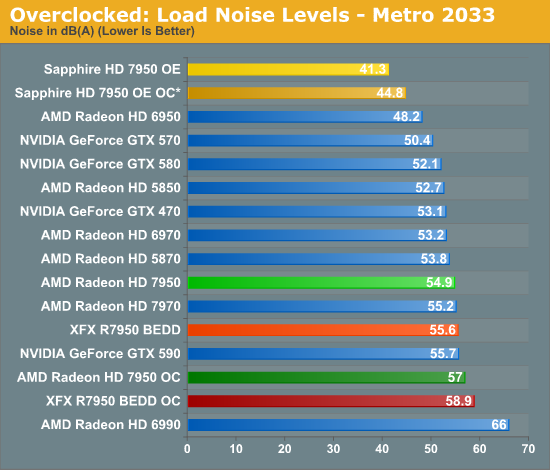AMD Radeon HD 7950 Review Feat. Sapphire & XFX: Sewing Up The High-End Market
by Ryan Smith on January 31, 2012 9:02 AM ESTOverclocking: Power, Temp, & Noise
In their marketing materials AMD is heavily pushing overclocking, and they have good reason to. With the 7970 we’ve established that Tahiti has quite a bit of overclocking headroom, and as the 7950 is clocked lower by default this opens up that headroom even further. Realistically AMD’s binning process means that the best clocking Tahiti GPUs are going to be allocated to the 7970 unless they have failed shaders, but even with that there’s quite a bit of potential on paper.
As with overclocking the 7970, our goal overclocking the 7950 is to see how much you can get for free; that is without any voltage adjustments. AMD’s reference PCBs are not particularly overbuilt for overclocking—cards like that will come later—so sticking to the reference voltage is the safest option, not to mention the easiest. With the 7970 we were able to get 200MHz (22%) overclocks without any voltage adjustment, and we’re hoping for the same out of the 7950.
With that said, we quickly ran into a wall on one card: the Sapphire 7950. Sapphire’s low VID of 0.993v may be great for temperature and noise at stock, but it’s not doing overclocking any favors. We only hit 950MHz at that voltage. As the Sapphire was the odd man out—every other card was at 1.093v—we did end up overvolting the Sapphire to 1.093v to see what it was capable of when put on similar footing as the rest of our cards.
After bringing up the voltage of our Sapphire card, all of our 7950s ended up overclocking to very similar levels. Our Sapphire and AMD cards topped out at 1025MHz core, a 225MHz (28%) overclock over a stock 7950 and a 125MHz (14%) overclock over the Sapphire’s factory overclock, while our XFX card reached 1050MHz, a 150MHz (17%) overclock beyond XFX’s factory overclock. Meanwhile the memory clocks on all of our cards topped out at 5.8GHz, beyond which we’d start seeing performance regressions from error correction on the memory bus.
| Radeon HD 7950 Overclocking | |||||
| AMD Radeon HD 7950 | Sapphire HD 7950 Overclock Edition | XFX R7950 BEDD | |||
| Shipping Core Clock | 800MHz | 900MHz | 900MHz | ||
| Shipping Memory Clock | 5GHz | 5GHz | 5.5GHz | ||
| Shipping Voltage | 1.093v | 0.993v | 1.093v | ||
| Overclock Core Clock | 1025MHz | 1025MHz | 1050MHz | ||
| Overclock Memory Clock | 5.8GHz | 5.8GHz | 5.8GHz | ||
| Overclock Voltage | 1.093v | 1.093v | 1.093v | ||
As you can imagine, with such similar overclocks, gaming performance on all 4 cards ended up being very similar. So we’ll get to gaming performance in a minute, while we’ll start with power, temperature, & noise.


Even though we’re not increasing the voltage on our AMD and XFX cards, merely overclocking them and raising the PowerTune limit to avoid throttling does drive the power consumption up. As is typical with heavily overclocked cards, overclocking quickly drives up power consumption and the 7950s are no exception. After overclocking power consumption is almost identical to the stock 7970, so while you can get 7970 performance you still need to pay the price with 7970 power consumption. Meanwhile it’s interesting to note that even with the extra 0.1v we’ve given the Sapphire card its final power consumption is only ever so slightly higher than the other 7950s, proving that voltage is the great equalizer in this case.


With the increase in power comes an increase in temperatures. The Sapphire card still does very well here staying in the low 70s even under OCCT, while the reference and XFX cards hit the high 70s under Metro and mid 80s under OCCT. As we’ve yet to really ascertain what the thermal limits are for Tahiti, it’s not clear whether there’s too much thermal headroom left for the GPU, particularly under OCCT.


Last but not least we have load noise. The Sapphire card is once more a stellar performer, and we still can’t get it above 50dB even with OCCT. Unfortunately the XFX 7950 BEDD has its biggest fallout yet—it may be able to overclock well, but at 64dB under OCCT the performance isn’t going to be worth the immense amount of noise it creates to move enough air to keep the GPU cool.










259 Comments
View All Comments
MattM_Super - Tuesday, January 31, 2012 - link
Yes I would enjoy more performance (esp at a lower power draw). I like to get ~60fps minimum @1080p. In games with fancy lighting effects, 4xAA, high res textures, like Witcher 2, metro 2033, crysis 2 dx11 current cards cant deliver that. Its a luxury sure, but one I am willing to pay for.I also think there is still plenty of room for improvement in graphics.
sleepeeg3 - Wednesday, February 15, 2012 - link
Bingo. The fanboys are too focused on bickering to realize these GPUs are blowing past 100fps on popular games. Who cares? Game companies stopped pushing the limits years ago.chizow - Tuesday, January 31, 2012 - link
Its funny because next-gen single-GPU performance *USED* to be measured against previous gen x2 GPU card or CF/SLI where we would expect 50+% increase over last-gen single-GPU.But yes its easy to ignore the fact the 580 also overclocks quite well. I don't know what would be worst though for a new 7950 or 7970 owner. Kepler launching and make these prices look like tragic comedy, or AMD releasing the HD89xx not too long after to make them feel even worst about their purchase.
Either way, you make a compelling argument against buying one of these cards today.
Master_shake_ - Tuesday, January 31, 2012 - link
you are obviously a fanboy,obviously you missed the part where the 7970 can oc to 1125 on the cvore and max out the vram clock with STOCK voltiage, and when you do so it beats BEATS the gtx 590 a current gen dual gpu card.
chizow - Tuesday, January 31, 2012 - link
While I value OC'ability, I don't consider OC to stock comparisons relevant because frankly, it makes no sense.Every card can OC to some degree so an apples-to-apples comparison should be the primary comparison with overclockability secondary.
Tchamber - Wednesday, February 1, 2012 - link
Rather than call you a fanboy, I would ask for an example of a high end card going against the previous gen x2 card...and bear in mind that ONCE does NOT consitute a trend. I think evolution of performance is always incremental, at least is has been since gtx200 and radeon 4000 series.chizow - Wednesday, February 1, 2012 - link
-GTX 280 was very close to as fast as 9800GX2Filter prevented a link for this, but google computerbase GTX 280 review and look at performance rating summary.
-GTX 480/580 was faster than GTX 295
Same deal, google 480 review for that site.
-GTX 680 should be very close to GTX 590 performance
What makes this easier on the next-gen GPU flagship is the last-gen X2 parts generally have to make sacrifices in either bandwidth, functional units, or clockspeeds to stay within TDP envelopes along with imperfect multi-GPU scaling, so you generally see only 50-75% scaling over the top single-GPU of that generation.
So you can look at it two ways, either next-gen should be ~50% faster than the top last-gen GPU, or it is very close to the last-gen X2 GPU card.
I'm trying not to take any shots at AMD fans, but their reactions to these Tahiti parts in light of historical price and performance leads me to believe they either have very low standards/expectations or they just haven't been paying attention to the industry.
Galidou - Saturday, February 4, 2012 - link
''they just haven't been paying attention to the industry''Wait, if I buy a GPU now, and I want the top single gpu for multiple screens, whatever the people in the world think about what I WANT, I realize that I have more power for my money by buying a 7970 and I go with it, it turns out that because I have done that, I'm an AMD fanboy because I haven'T been paying attention to the industry?
OMG I'm such a tard, I forgot I haven'T paid attention to the industry so I should of paid more for a less performing card..... darn that's how stupid I am.....
chizow - Saturday, February 4, 2012 - link
If you absolutely had to have a new card today, sure you'd have some reason to buy a 7970, but still not at these prices imo.If you wanted to maximize your return on the dollar however, you'd be much better off waiting for Kepler because even if the 7970 still suits your needs better at that point, Kepler will almost assuredly force downward pressure on all Tahiti AND Fermi parts and force AMD and Nvidia to adjust prices accordingly. In the past AMD has done this when they launched a next-gen part first (See: 5850/5870 launch), but not this time.
This actually reminds me a lot of the X1950XTX launch. Great performance when it launched and price perfectly justified compared to Nvidia's last-gen G70/G71 designs like 7900GTX and 7950GT. But as soon as G80/8800GTX launched a few months later, it made that buy decision look horrible in retrospect.
So yes, while a X1950XTX today, er I mean 7970 today looks perfectly justified, it would be a mistake to ignore what the future holds and what the past has told us when making a buying decision.
Galidou - Sunday, February 5, 2012 - link
What about the pricing of gtx 280 at launch vs the price of 8800gt were selling? There's always an example about Ati making bad pricing decisions, but nvidia... not out of your mouth?I'm no ATI fanboy, I'm just waiting for you to show us you see the other side of the medal...
Those GTX 280 650$ at launch while the 8800gt was about 55-65% of the performance of that card but HEY it was three times cheaper... No you haven't heard of? Oh I forgot, Nvidia makes no mistakes, it's ATI that did with the 4870 pricing it so low, but Nvidia... they make no mistake.
But hey the price of the 7970 accordingly to it'S performance is SO BAD compared to the triple price of that GTX 280 for not even double the performance over that nice 8800gt...